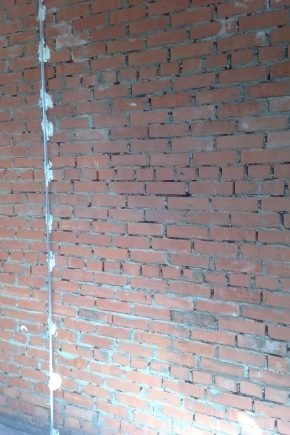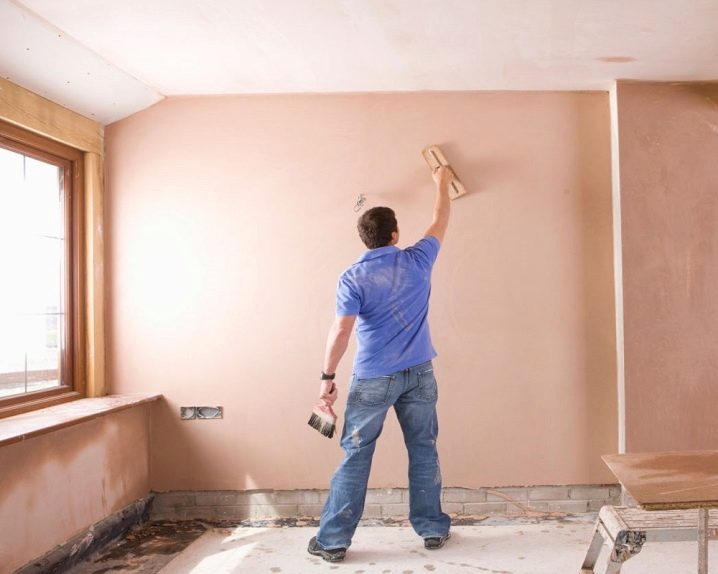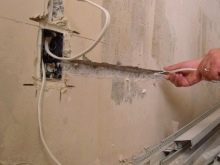How to plaster the walls and ceiling of the lighthouses?

After buying an apartment in a new building, everyone is faced with the problem of finishing the apartment. An important component that requires a lot of patience and painstaking care in such a cosmetic repair is the plastering of the walls. Often, during the construction of a house, craftsmen do not think about what it is necessary to make the walls even, so the new owners are experiencing a lot of difficulties. However, in the modern world, there is a good plastering method that will help simplify this long and laborious task. This is a new technique whereby walls and ceilings are aligned with lighthouses. Let's consider the nuances of this process.


Peculiarities
The method of plastering walls on lighthouses has several features. Lighthouses are a kind of guides that limit the plane of the surface intended for alignment. If you position them correctly, correlating the position with the geometric shape of the room, you can easily reduce labor costs during the alignment of the walls. It is necessary to make a forecast of the plaster consumption at the stage of choosing the initial surface (the one along which they will be guided in the future when exposing the planes of other walls).


When using ready-made beacons, a certain amount of the useful volume of the room to be finished is reduced. The material itself reduces the area of \ u200b \ u200bthe room, since over its entire length it has the same thickness dimensions. Better not to put plaster underneath the entire lighthouse. It is preferable to lay it out with an angle between the base wall, which should be perpendicular to the other two, and the material itself. It will help make the wall smoother.
Using this method, you can save on the amount of plaster used and save usable space in the room.

If you correctly align the walls with beacons, you can get a perfectly flat surface with a guaranteed result. But the final result is significantly influenced by the correct placement of the profiles. To correctly carry out the finishing work, you can use the plumb line system. A couple of plumb lines must be lowered along the edges of the wall. Then two slats are installed vertically along these two plumb lines, the threads are pulled between them (a flat vertical plane is obtained along which plastering can be performed).

To simplify the task of setting up beacons, some manufacturers have prepared special metal or plastic mounts. Such details are best used by beginners in the early stages of wall alignment. They will allow you to increase the pace of work and further reduce labor costs for plastering. When inviting builders to work on plastering walls, it is important to know that they themselves need to fulfill production quotas, which are about 10 hours per room. You can do it yourself faster and better.


Varieties
There are several types of beacons used to level the walls.
- Wooden lighthouses are made from a solid block of wood. They can be found anywhere. The price of this product is low, which attracts buyers.
- Profiles made of light metals or plastic are specially designed beacons.They have the shape of the letters "L" or "T", they are well connected to the base, on which glue or a layer of mixture for plastering is subsequently smeared.
When purchasing such profiles, it is important to pay attention to the rigidity of the material. Those beacons that are made of too thin a sheet of metal will bend, therefore, can create great difficulties during work. Metal beacons cannot be warped, unlike wooden bars.




Metal profiles can be used many times, if necessary, they can be left in the wall. However, this material can rust over time, therefore it is recommended to remove the profiles after successful plastering of the surface.
- Lighthouses for leveling walls from a plaster mixture are made with their own hands according to the following scheme.
- It is necessary to evenly place the chain of nails, using plumb lines for this.
- After the strip of nails is created, you need to apply lime dough or plaster mixture to their caps.
- After the solution has hardened, its excess is removed to the level of the caps.
- Then, a straight long bar should be attached to the formed tubercles and the solution should be applied into the gap formed.
- When the solution hardens, the block must be removed by knocking along its entire length.


As a result of these manipulations, an even plaster beacon is obtained, which is convenient to navigate by when leveling the walls.
Application area
The beacon method of leveling surfaces has a wide range of applications. Light metal profiles are used to level the ceiling surface. However, in this case, there are several important nuances that must be considered when finishing. With a large height difference on the ceiling, it is recommended to apply plaster without the use of beacons, since a layer with a large thickness may fall. Even the application of an intermediate layer of primer will not correct this situation.


With the help of lighthouses, you can level drywall sheets if, for any reason, they have holes or depressions.
Important to remember: completely using the beacon method, only moisture-resistant gypsum plasterboards should be plastered. Plasterboard surface should be plastered only in parts. It is important to prepare the drywall before applying the plaster. It is necessary to clean it of various contaminants, remove dust and only then apply the plaster mixture.


How to level drywall?
Profiles made of light metal or plastic, when leveling drywall, act as an auxiliary guide to create a perfectly flat wall surface. In this case, the size of the rail height should be minimal, about 6 mm, so that the plaster layer is thin and adheres well to the sheets. It is necessary to plaster the surface in a warm room with normal humidity; to maintain health, it is better to use a respirator and gloves. For leveling drywall, you need to use only gypsum-based plaster mixes.


Recommendations for concrete
Concrete can also be plastered using the beacon method. This happens according to a certain technology.
- Initially, it is necessary to remove all damage from the wall, including pits and bulges.
- It is necessary to lay channels for communications and electrical wires.
- It is necessary to prepare a concrete surface for plastering (clean it from dirt, and then prime it).
- It is worth attaching a special mesh for plastering to the wall using dowels and washers.



After that, you can attach the lighthouse to the wall. First, fix the self-tapping screw or dowel under the ceiling on the wall at a distance of about 15 cm from the corner. The gap between the head and the wall determines the thickness of the plaster. Then, next to the floor, opposite to the first sample, they put the second one, which must be placed on the same vertical with the first one. Between them, it is necessary to put pieces of plaster of paris, which should be above the level of samopezov.



After that, it is worth attaching a metal or plastic profile to the casings and drowning it in plaster. The correct location of the lighthouse must be checked with a building level. If you deviate from the ideal horizontal, you need to slightly twist or unscrew one of the samopezov and recheck the position of the rail. All these manipulations can be performed until the beacon is fixed strictly vertically. It is also necessary to install a beacon from the other edge of the wall.

A rope should be stretched between the slats and the remaining beacons should be installed between them along its length.
The distance between the profiles should be less than the length of the rule that will align the walls. At the end, all slats should be in the same vertical plane. The same method is used when plastering aerated concrete wall panels.


Installation methods
Professionals use many different methods of installing beacons. Therefore, there is a lot of controversy about which method of setting the ball system is the best. Consider several methods for installing profiles that are fully available for self-assembly.
With a laser level
The placement of beacon profiles is designed to create a single, full plane, which should be set using two lines perpendicular to each other. One helps to calculate the thickness of the plaster layer, and the other is a strictly vertical line along which plastering takes place. The advantage of a laser plotter is that you can build two lines at once with it. After that, installing lighthouses no longer seems so difficult. The cost of such a device is quite high; not every person can afford to purchase it for repair. Most often it is bought by professional builders, provided that this laser builder will be reused.



On plumb lines
In the absence of a laser level, you can use an older and proven method: installation of profiles along plumb lines. The latter are usually two cords, which are attached to the ceiling near the corners. Several horizontal lines are marked on the wall itself, which set the step from one dowel to another. Then another cord is pulled perpendicularly to the first two ropes. It is called a slider and is used in cases where it is necessary to accurately mark the gaps between all future holes for the dowels, on which the beacons will subsequently be attached.


String method
This method appeared not so long ago, but has already become quite popular. It has a lot of advantages that are difficult to dispute. For example, this is the simplicity and speed of setting profiles, options for horizontal and vertical installation, as well as convenient application of plaster. In order to install one profile in this way, two channels for fastening are needed, in which the tension and adjusting bolts must be installed.

The role of the string in this case is played by an elastic wire made of high quality steel (with a diameter of about 1.5 mm).

With mounts
This method of installing beacons is more suitable for renovation beginners and non-professionals. The fixing of such fasteners for mounting profiles must be done strictly following the instructions with which they are sold. The installation of this material depends entirely on its type.


How to install beacons?
Beacons can be installed using several technologies. There are many video master classes that explain how to mount profiles. They often contradict themselves. Installation of lighthouses can be done in several stages.
From the very beginning, you need to carefully examine the surface of the walls along the vertical plane, using a level... The most noticeable deviations from the norm should be noted with a marker on the wall. Then, using a level, you should examine the wall along a horizontal plane.It is better to remove the most noticeable bulges (cut off with a perforator).


Then you need to remove the markings for the beacons. You need to start from the corners: it is important to move away from them by about 30 cm (the minimum tolerance is 25 cm). Further, it is necessary to make marks that are about 160 cm apart from each other, so that the rule can reach from one lighthouse to another. At the same time, you cannot divide the wall into unequal parts. For example, if there are about 2 meters of surface left during the marking, it is better to set the profile at the mark of 1 m.


After that, it is necessary to remove all dust and other dirt from the wall, and then treat it with a deep penetration primer. These manipulations will help preserve the integrity of the wall, protecting it from mold and mildew. After waiting for the wall to dry completely, it is worth taking a metal profile, attaching it to the line outlined in advance and screwing a self-tapping screw into the upper part of the lighthouse. Then it is necessary to fix a plumb line to the screw head, which will help you navigate the places where you need to make holes for other screws.


It is necessary to align the lighthouse so that it forms a flat vertical plane. If it does not work out, you need to pull out the self-tapping screws and align the beacon with a plumb line until it is installed evenly.
Only after obtaining the ideal result can the plumb line be removed. The same work needs to be done with other lighthouses.
It is important to fix the lighthouses with plaster in several places. so that some of them are inside the plaster layer. Then it is worth leaving the structure for several hours, so that it could dry out. It is imperative to check the dryness of the plaster on the lighthouses, otherwise the integrity of the structure can be violated. After that, you can start plastering the wall.


After completing these manipulations, you can leave the lighthouse profiles only if you subsequently plan to lay out the wall with ceramic tiles. In all other cases, beacons should be removed. Wallpaper or paint cannot hide the presence of beacons in the wall. Therefore, after completing the plastering process, it is better to dismantle the profiles. It is necessary to remove all self-tapping screws, pull the beacons out of the walls, then seal the holes with plaster.
The process of applying the mixture
In most cases, gypsum plaster mixes are recommended for do-it-yourself wall leveling.

Such a plaster solution has a large number of advantages:
- This plaster is characterized by high plasticity level.
- The layers of this mixture can have a large thickness, the surface after the repair is not covered with cracks.
- Plaster with gypsum will provide a high level of sound and thermal insulation.
- It will not have precipitation and lumps on the surface of the walls.

In advance, holes and recesses in the wall must be sealed with cement mortar and allowed to dry. Before starting plastering, you need to carefully stir the mixture with a perforator. Only then can you start distributing the plaster over the surface. When applying the mortar, it is better to use a wide trowel so that a thick layer of plaster can be applied. It is necessary to level the layers of the plaster mixture from the bottom up, using the rule (a bar of smooth reinforcement). It is better to remove the excess after leveling the plaster so that it does not dry out and does not interfere with the finishing work.



Tips & Tricks
There are many tips and tricks that experts can give a beginner. There are no hard and fast rules, each master has his own secrets. Let's consider the main ones:
- When installing beacons using fasteners, it is necessary to take into account that after such fixation, the profiles are more difficult to remove from the wall, removal is necessary in order to avoid oxidation of the beacons and extend the life of the plaster.
- It is better to use special rods to install beacons. They should not exceed a length of 80 mm, and should be about 8 mm thick.
- For a good distribution of the solution, it is necessary to master the method of application with special throws. In this way, voids on the surface of the walls can be prevented.
- In order not to waste an extra package of plaster mortar, it is necessary to immediately designate the highest section, which will become the starting point for the new height of the walls.


After the installation of the lighthouses, it is necessary to calculate the approximate consumption of the plaster mixture per m2 of the wall.
This can be done as follows:
- measure how far each beacon deviates from the plane of the wall;
- the results must be added and then divided by the wall measurements.
The value that will be obtained during the calculations will be the layer thickness. The consumption of the plaster solution necessary to create a smooth wall depends on it. Please note that the layer should not be less than the width of the lighthouse. The lighthouse is on average 6 mm thick. This must be taken into account when calculating the amount of plaster.
How to align the walls with the lighthouses, see the next video.













The comment was sent successfully.